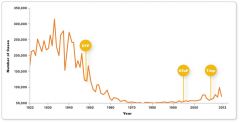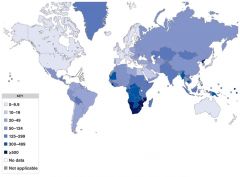![]()
![]()
![]()
Use LEFT and RIGHT arrow keys to navigate between flashcards;
Use UP and DOWN arrow keys to flip the card;
H to show hint;
A reads text to speech;
45 Cards in this Set
- Front
- Back
|
Upper Respiratory System
|
Nose, pharynx,middle ear, and eustachian tubes
Saliva andtears protect mucosal surfaces |
|
|
-Lower Respiratory System
|
- Larynx,trachea, bronchial tubes, and alveoli - Ciliaryescalator moves particles toward the throat via ciliary action - Alveolarmacrophages destroy microorganisms in the lungs - Respiratorymucus protects mucosal surfaces - Nearly sterile |
|
|
Ciliary Escalator
|
moves particles toward the throat via ciliary action
|
|
|
Alveolar macrophages
|
- Keeps lower respiratory system mostly sterile by destroying microorganisms in the lungs
|
|
|
Respiratory Mucus
|
- Protects mucosal surfaces of the lower respiratory system
|
|
|
Pharyngitis
|
- Sore throat
|
|
|
Laryngitis
Tonsillitis Sinusitis |
- Inflammation of the larynx - Inflammation of the Tonsils - Inflammation of the Sinus * Usually self-limiting |
|
|
Epiglottitis |
- Most life threatening disease of the upper respiratory system
|
|
|
Streptococcus pyogenes |
- Gram Positive Aerobic
- Group A Streptococci |
|
|
- Necrotizing fasciitis - Toxic shock syndrome - Pharyngitis - Scarlet fever - Puerperal Sepsis (Gram Positive) |
5 Diseases caused by streptococcus pyogenes
|
|
|
Strep Throat |
- Local inflammation, fever, tonsilitis, enlarged lymph nodes
- Resistance to phagocytosis; Streptokinases lyse clots; Streptolysins are cytotoxic - Diagnosis: enzyme immunoassay (EIA) tests |
|
|
Scarlet Fever
|
- Red Strawberry Tongue caused by toxin causing pinkish red skin rash
- Erythrogenic toxin produced by lysogenized bacteria |
|
|
Diphtheria
|
- Caused by corynebacterium
- Sore throat followed by general malaise and swelling of throat; forms tough grayish membrane in the throat which is fibrin and dead tissue that can block the passage of air to the lungs |
|
|
Diphtheria
|
- circulates in the blood and damages the heart and kidneys
- Leading infectious cause of death in children until 1935; exotoxin produced by lysogenized bacteria that circulates in the blood and damages the heart and kidneys; spread by droplet transmission - Prevented by DTaP vaccine |
|
|
1. Cutaneous
2. Skin ulcers |
__1__ diphtheria causes __2__
|
|
|
1. Viral 2. Bacterial |
Sneezing, nasal secretion, congestion without fever is usually ___1___. With fever is usually ___2___. |
|
|
Rhinovirus (30-50%)
Coronavirus (10-15%) |
2 Viruses known to cause common cold and their percentage of cases
|
|
|
common cold
|
- Over 200 different viruses
- Sneezing, nasal secetion, congestion - Leads to laryngitis and otitis media not accompanied by fever - Thrive in temperatures lower than body temperature; viruses remain viable on surfaces touched by contaminated fingers for hours (Fomites) - antihistamines treatment |
|
|
1. Whooping Cough
2. Negative 3. Aerobic 4. Coccobacillus 5. Capsule |
____1___ is caused by Bordetella pertussis which is a Gram ___2__ __3___(aerotolerance) __4__(shape) that produces __5__ (structure).
|
|
|
Whooping Cough Pertussis
|
Capsule allows attachment to ciliated cells in the trachea, destroys these and shuts down the ciliary escalator; tracheal cytotoxin of cell wall damages ciliated cells; toxin enters the bloodstream
- before vaccines, 6000 people died annually in the U.S.; aggressive coughing can can cause brain damage in infants or break ribs in children or burst blood vessels in eyes, bruising of eyes, organ damage - 3 stages |
|
|
Whooping Cough Pertussis
|
Stage 1: Catarrhal stage - Cold-like symptoms. Stage 2: Paroxysmal stage -Violent coughing, gasping for air, accumulated mucous has accumulated and patient tries to clear it
Stage 3: Convalescence stage may last for months Prevention: DTaP vaccine; Treatment: with erythromyocin or other macrolides |
|
|
1. Tuberculosis
2. Mycobacterium 3. aerobic 4. rod 5. Mycobacterium tuberculosis 6. Mycobacterium bovis 7. Mycobacterium avium-intracellulare complex |
___1___ is caused by ___2___ genus which is an acid-fast __3__(aerotolerance) __4__(shape) with a 20 hour generation time. The three causative species are ___5___, __6__ and ___7___. |
|
|
Mycobacterium
|
Genus - Inhaled organisms are phagocytized by alveolar macrophages with spread mycolic acids from its cell wall to stimulate inflammatory response; organisms are isolated in the walled-off tubercle; tubercles heal and become calcified called Ghon's complexes; tubercle breaks down, releasing bacteria into the lungs and cardiovascular/lymphatic system
|
|
|
Slide 15
|
Slide 15
|
|
|
Tuberculosis
|
- Disease where Lipids in the cell wall make it resistant to drying and antimicrobials and avoid immunity; military type associated with disseminated infection; 9 million develop annually; 2 million die; 1/3 of world's population infected; leading cause of death for those with HIV
|
|
|
1. T-cells
2. delayed 3. acid-fast 4. 6 month 5. BCG 6. bovine |
Tuberculin skin test: positive reaction means a current or previous infection; ___1___cells react with purified protein derivative from the TB bacterium by ___2___ hypersensitivity induration; followed by X-Ray or CT exam; __3__ staining of sputum and bacteria culturing; new rapid blood test for IFN-y and PCR test with higher specificity and less cross-reactivity; Treatment: __4__ minimum drug therapy due to slow growth and dormancy; first-line drugs, second-line drugs, multi-drug resistant strains, extensively drug-resistant strains; Prevention: ___5___ vaccine: live culture of avirulent M. ___6___ not widely used in the US from questionable effectiveness
|
|
|
1. bovine 2. avium intracellulare complex |
Mycobacterium __1__ causes tuberculosis in cattle, less than 1% of cases. Mycobacterium ___2___ infects people with late-stage HIV infection
|
|
|
Pneumonia
|
- Typically caused by Streptococci - about 90 serotypes - Gram positive encapsulated diplococci
- Other microorganisms are atypical - Symptoms: High fever, breathing difficulty and chest pain |
|
|
Pneumonia |
- Infected alveoli of the lung fill with fluids and RBCs interfering with oxygen uptake
- Diagnosis: Optochin inhibition test, bile solubility test or antigen in urine; Prevention: conjugated vaccine |
|
|
Influenzavirus
|
- Contains 8 RNA segments and outer lipid bilayer
- Chills, fever, headache and muscle aches with no intestinal symptoms - 30-50,000 deaths in the U.S. annually; Avian, swine and mammalian strains; Swine serve as "mixing vessels" for new strains; Hemagglutinin (HA) spikes which recognize and attach to host cells; Neuraminidase (NA) spikes which helps virus separate from the infected cell; 1% mortality, usually very young and very old |
|
|
- Influenza |
- Antigenic drifts: Allow minor antigenic changes in HA and NA, allow virus to elude some host immunity; Antigenic shifts: Allow changes great enough to evade most immunity which can lead to pandemics and involve the reassortment of the 8 RNA segments
- Prevention: Multivalent vaccine for the most important strains - composition of the vaccine determined annually by the identification of circulating viruses which is labor-intensive to produce and does not form long-term immunity; difficult to diagnose form clinical symptoms; Treatment: zanamivir (Relenza) and oseltamivir (Tamiflu) which inhibits neuraminidase |
|
|
Pertussis |

|
|
|
Tuberculosis |

|
|
|
HIV |
Causes by lentivirus (retrovirus) |
|
|
HIV |
- Two identical strands of RNA; reverse transcriptase enzyme; phospholipid envelope - gp120 glycoprotein spikes help interact with T cell receptors |
|
|
1. Dendritic cells 2. T cells 3 gp120 4. CD4+ |
HIV is spread by ___1___ and carried to lymphoid organs, contacts activated ___2___. __3__ spikes combine with __4__ receptor, which are carried on __2__ helper cells, macrophages and dendritic cells. Virus fuses and enters the cell. |
|
|
Reverse transcriptase |
Enzyme used by Lentivirus to transcribe own DNA, integration |
|
|
Provirus |
Term for Virus that is hidden in chromosome to stay latent |
|
|
1. Helper 2. Macrophages 3. Vacuoles 4. Antigenic |
Some become ___1___ T cells that serve as reservoir for HIV, some __2__ can have virons in their __3__. Virus undergoes rapid __4__ changes and high rate of mutation. Antibodies ineffective. |
|
|
HIV 1 |
- viruses that infect chimpanzees and gorillas - 99% of cases - group m (majority) accounts for 90% |
|
|
HIV 2
|
- Related to viruses that infect monkeys and sooty mangabeys - Not often encountered outside of Africa - Less pathogenic than HIV-1 |
|
|
HIV
|
Phase 1: asymptomatic or lymphadenopathy (Swollen lymph nodes – Innate Immunity)Provirus Phase 2: CD4+ T cells decline steadily; only a few infected cells release the virus; few serious disease symptoms (persistent infections, fever, and oral leukoplakia) Phase 3: AIDS develops; the CD4+ is count below 200 cells/μl; indicator conditions |
|
|
HIV
|
- Initial strong and effective immune responseCTLs=CD8 - T- cells suppress viral numbers - Attack viral CD4+ T cells - Once HIV establishes a pool of latently infected CD4+ T cells, it is impossible to clear the infection - Challenge to make a vaccine |
|
|
HIV
|
- Older adults and young children do not a have fully developed immune system, making them more susceptible - Exposed, but not infected populationCCR5 mutation on the CD4+ receptors so HIV cannot bind- Long-term nonprogressors “survivors” stay at Phase 1 - Low viral load - HIVEffective CTLs |
|
|
HIV
|
- Antiviral Therapy (PG 542) Prevent provirus Prevent release of virons Prevent reverse transcriptase |

